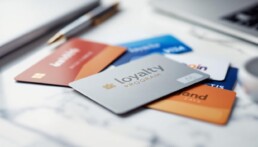
Loyalty programs are evolving rapidly, and businesses need to keep up with the latest trends to stay competitive. At Reward the World, we’ve seen firsthand how expanding the reach and appeal of these programs can significantly boost customer engagement and retention.
One key strategy that’s gaining traction is the use of cross-brand partnerships, allowing companies to offer a wider range of rewards and experiences. In this post, we’ll explore innovative ways to enhance your loyalty program and attract a broader audience.
How Technology Supercharges Your Loyalty Program
Technology transforms loyalty programs from simple point-collection systems into powerful engagement tools. At Reward the World, we’ve observed how tech-driven solutions amplify engagement and retention rates.
AI-Powered Personalization: A Revolution in Rewards
Artificial Intelligence (AI) predicts customer preferences and behaviors with remarkable accuracy. This enables hyper-personalized rewards that resonate with individual customers.
AI in beauty for personalization can lead up to a 20% increase in sales across the board, according to recent reports.
Mobile Apps: Loyalty in Your Pocket
Mobile apps put your loyalty program at customers’ fingertips. A well-designed app allows easy point checking, reward redemption, and promotion participation.
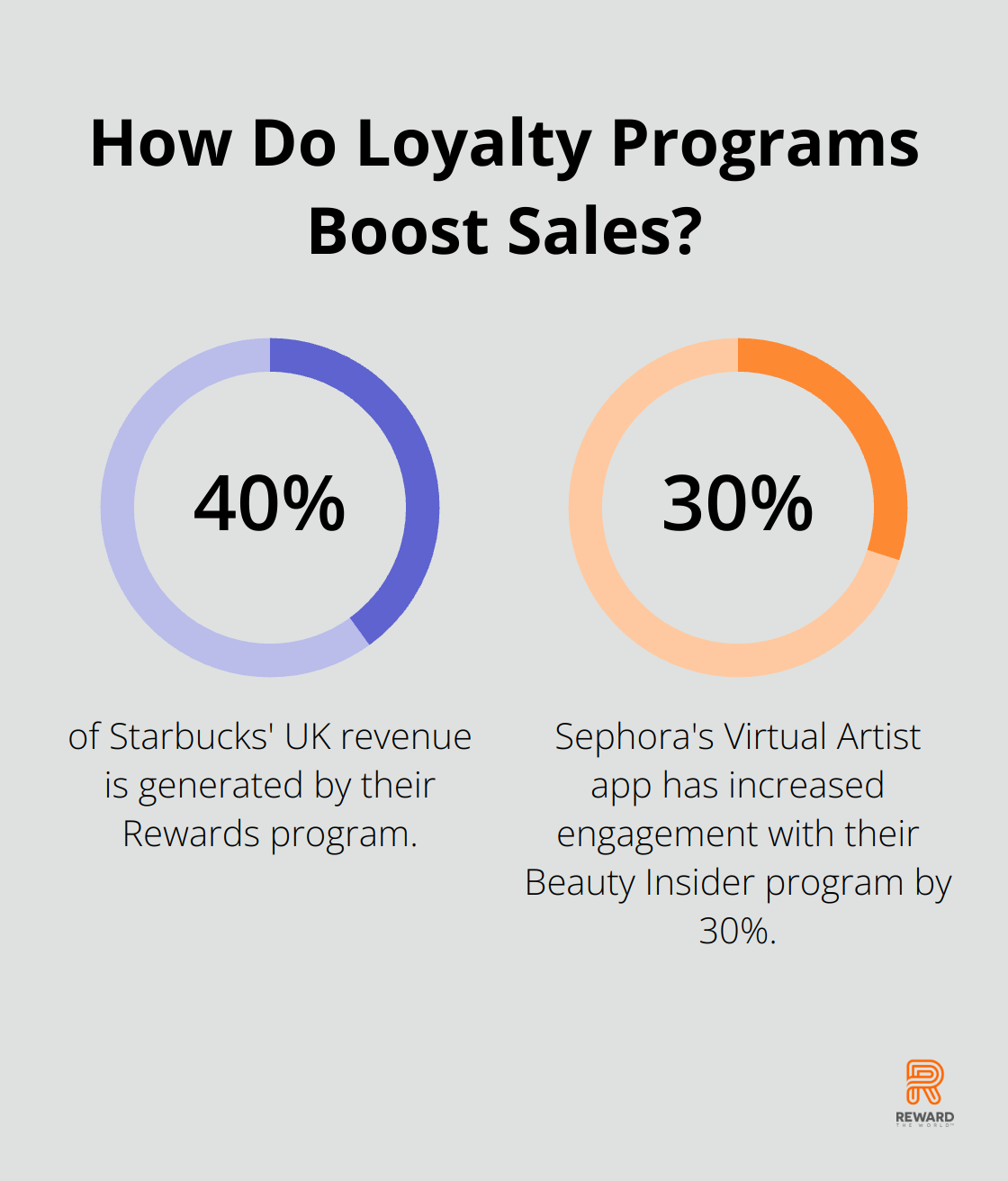
Starbucks leads in this area. Their Rewards program generates a whopping 40% of the brand’s UK revenue. The app’s convenience (mobile ordering and payment) combined with personalized offers keeps customers engaged.
Social Media Integration: Amplifying Program Reach
Social media integration expands your loyalty program’s visibility and appeal. It empowers customers to share rewards and experiences, turning them into brand ambassadors.
Nike’s Run Club app showcases effective social integration. Users share runs on social platforms, earn rewards, and motivate others. This social aspect has helped Nike build a community of over 100 million loyal customers worldwide.
Blockchain: Enhancing Security and Transparency
Blockchain technology adds a layer of security and transparency to loyalty programs. It prevents fraud and ensures fair reward distribution.
Travel loyalty programs are becoming outdated and blockchain-based token systems may be the new solution.
Virtual and Augmented Reality: Immersive Loyalty Experiences
Virtual (VR) and Augmented Reality (AR) create immersive experiences that enhance loyalty program engagement. These technologies transform how customers interact with brands and redeem rewards.
Sephora’s Virtual Artist app (which uses AR to let customers try on makeup virtually) has increased engagement with their Beauty Insider program by 30% (company report).
As we move forward, let’s explore how diversifying reward options can further expand your loyalty program’s appeal and reach.
Supercharge Your Rewards Mix
Diversifying your loyalty program’s rewards can significantly boost its appeal and reach. A varied rewards mix transforms customer engagement and keeps your program fresh and exciting.
Beyond Points: The Power of Experiences
Experiential rewards have become increasingly popular. This trend extends to loyalty programs, with studies showing their impact on customer behavior in various markets.
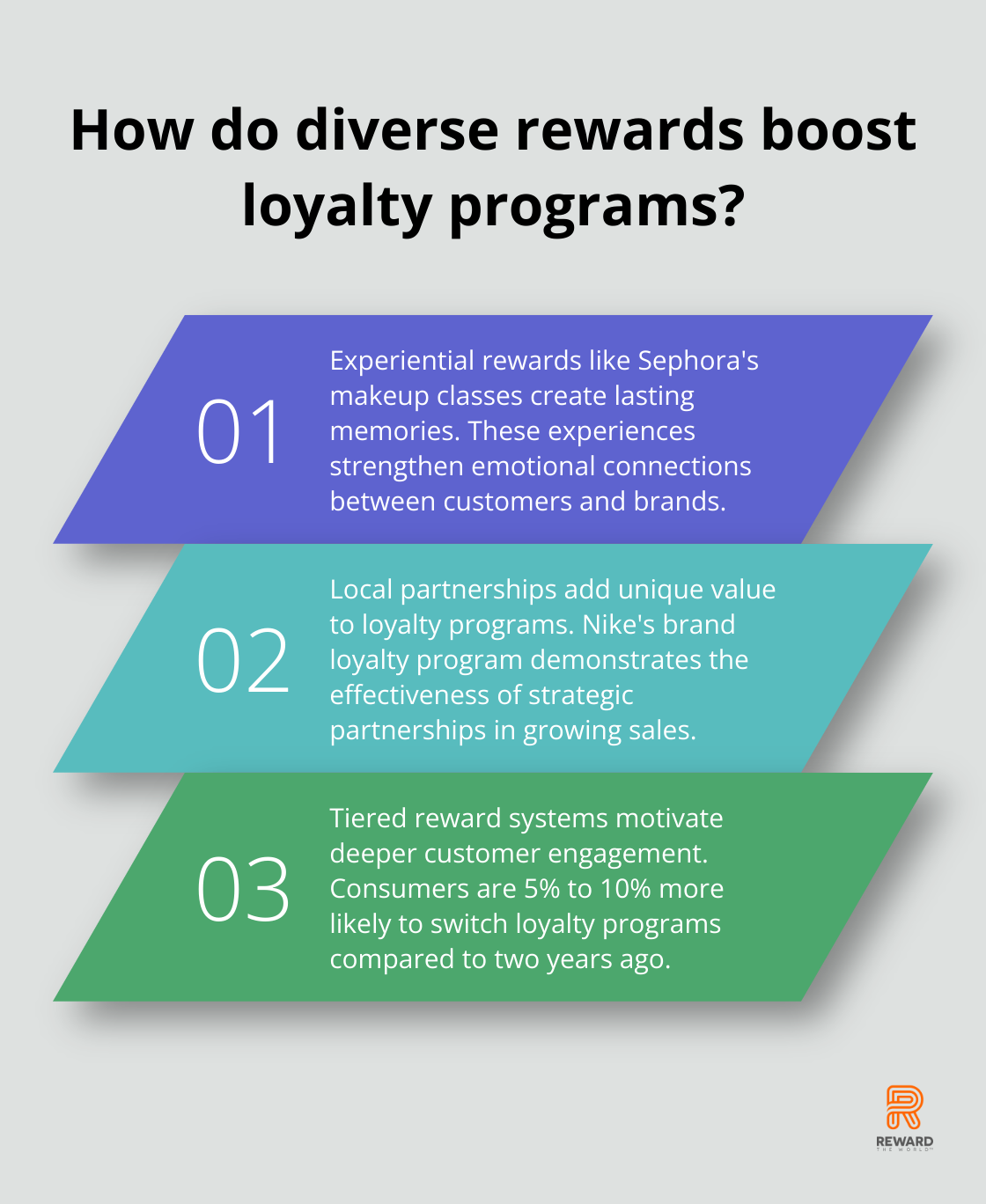
Sephora’s Beauty Insider program offers makeup classes and exclusive events, which drives engagement and fosters a sense of community. These experiences create lasting memories, strengthening the emotional connection between customers and the brand.
Local Partnerships: A Win-Win Strategy
Local partnerships add unique value to your loyalty program. Nike’s brand loyalty program, for example, demonstrates the effectiveness of building a strong loyalty scheme and growing sales through strategic partnerships.
For smaller businesses, local partnerships prove equally effective. A neighborhood bakery might team up with a nearby yoga studio, offering discounted classes as rewards. This approach not only diversifies rewards but also supports the local community.
Tiered Systems: Encouraging Progression
Tiered reward systems motivate customers to engage more deeply with your brand. American Express’s Membership Rewards program exemplifies this, offering increasingly valuable perks as members progress through tiers.
Recent data suggests that consumers are 5% to 10% more likely to consider switching to another loyalty program within the same industry compared to two years ago. This highlights the importance of offering compelling rewards to retain customers.
Customizable Reward Options
Offering customizable reward options allows customers to choose rewards that align with their preferences. This personalization increases the perceived value of the rewards and enhances overall program satisfaction.
For instance, Amazon’s Prime Rewards Visa Signature Card lets cardholders choose between cash back, travel rewards, or gift cards (providing flexibility that caters to diverse customer needs).
Sustainable Rewards: Appealing to Eco-Conscious Consumers
Incorporating sustainable rewards into your loyalty program appeals to environmentally conscious consumers. These rewards might include donations to environmental causes, eco-friendly products, or carbon offset credits.
Patagonia’s Worn Wear program rewards customers for trading in used Patagonia gear, promoting sustainability and brand loyalty simultaneously.
As we explore ways to expand your loyalty program’s reach, let’s now turn our attention to targeting underserved demographics and how this strategy can unlock new growth opportunities for your business.
Reaching New Audiences: Strategies for Loyalty Program Expansion
Expanding a loyalty program’s reach requires tapping into underserved demographics. This strategy unlocks new growth opportunities and ensures program relevance in a rapidly changing market.
Gen Z and Millennial Engagement
Gen Z tends to be more value conscious when it comes to loyalty programs. They like rewards that they can attribute a value to, and they are more likely to do research before making purchasing decisions. Loyalty programs must evolve to capture their attention.
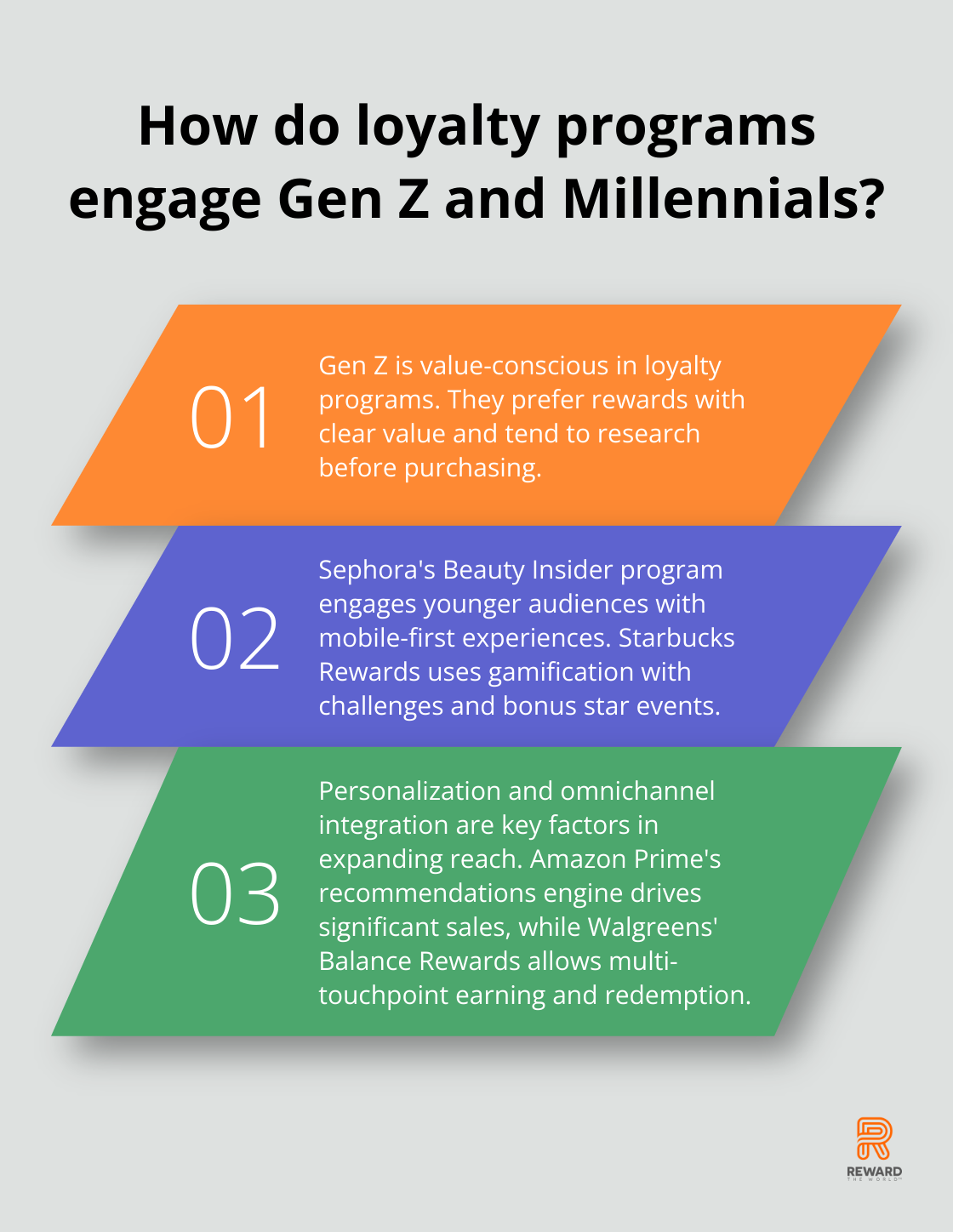
Sephora’s Beauty Insider program excels at engaging younger audiences. It offers mobile-first experiences, personalized product recommendations, and exclusive events.
Gamification proves effective for younger demographics. Starbucks Rewards uses this approach with its challenges and bonus star events.
Inclusive Rewards for Diverse Populations
Diversity and inclusion are essential components of modern loyalty programs. Brands that recognize and cater to diverse populations see higher engagement rates.
Fenty Beauty has driven the industry towards inclusivity, emphasizing the importance of diversity and representation. This approach has led to increased program sign-ups among underrepresented groups.
Language accessibility broadens a program’s appeal. Reward the World’s platform (available in 15 languages) demonstrates how multilingual support can significantly expand a program’s reach.
B2B Loyalty Initiatives
B2B loyalty programs present significant opportunities but require a different approach from B2C initiatives.
B2B partnerships are evolving into Partner Ecosystems to leverage network effects, enhance revenue, and strengthen resilience during economic downturns. This approach has contributed to an increase in partner-driven revenue.
Smaller B2B companies should consider offering exclusive industry insights or early access to new products as rewards.
Personalization at Scale
Personalization remains a key factor in expanding loyalty program reach. Advanced data analytics and AI enable programs to tailor rewards and experiences to individual preferences.
Amazon Prime demonstrates the power of personalization at scale. Its recommendations engine drives a significant portion of the company’s total sales.
Omnichannel Integration
Seamless integration across all channels (online, mobile, in-store) enhances program accessibility and appeal. Walgreens’ Balance Rewards program exemplifies this approach, allowing members to earn and redeem points across multiple touchpoints.
This omnichannel strategy has resulted in increased customer retention for Walgreens (highlighting the importance of a unified loyalty experience).
Final Thoughts
Expanding your loyalty program’s reach requires innovation and adaptability. Technologies like AI-powered personalization and mobile apps create tailored experiences that drive engagement. Diversifying rewards through experiential offerings and cross-brand partnerships caters to a broader range of customer preferences.
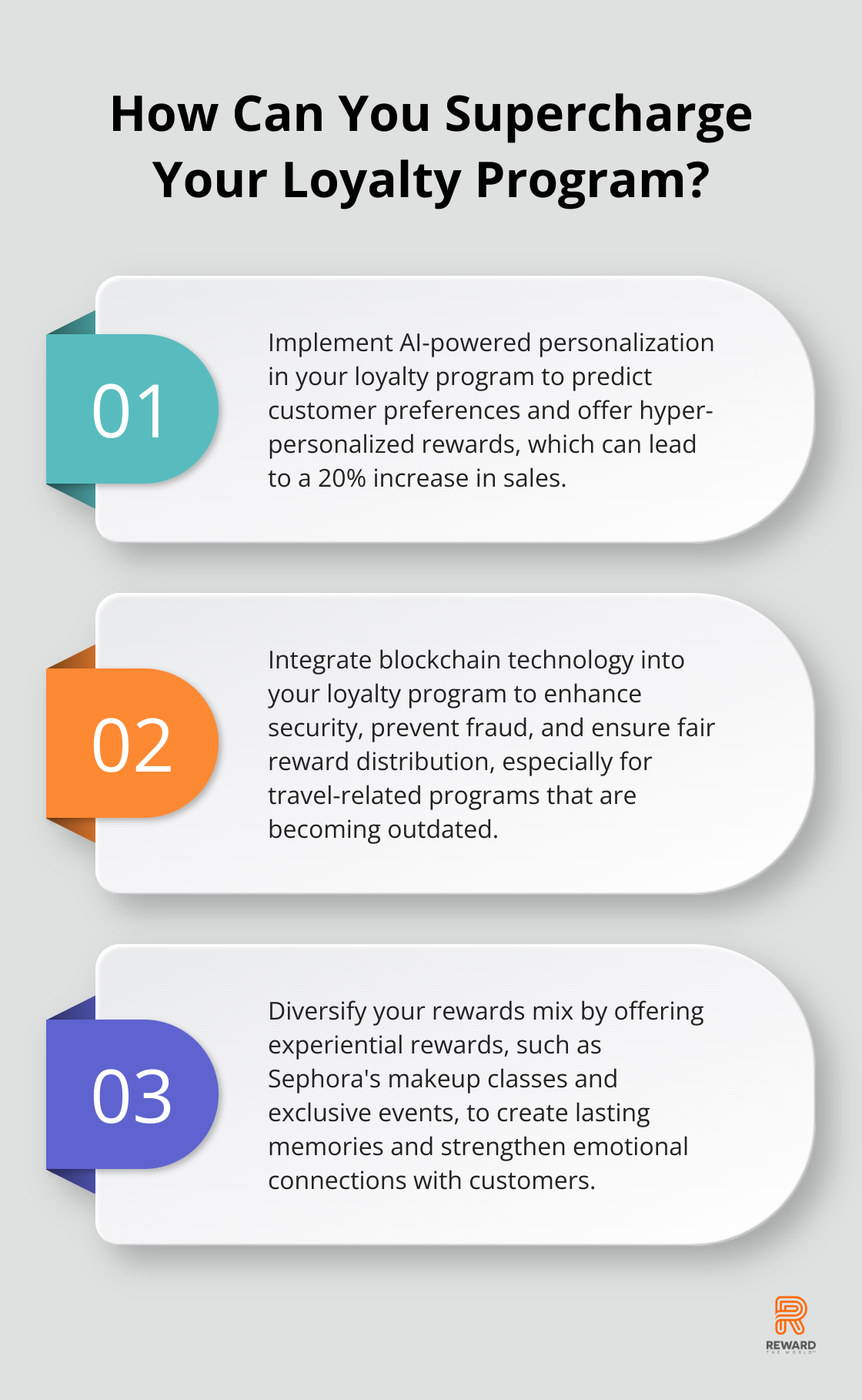
Targeting underserved demographics, such as Gen Z and B2B customers, opens new growth opportunities. Continuous innovation in loyalty marketing keeps programs relevant and effective. Businesses must stay ahead of trends and offer fresh, exciting rewards to maintain program effectiveness.
Reward the World’s global incentives platform offers a turnkey solution for fostering customer loyalty and increasing sales conversions. Our platform provides instant reward delivery, seamless integration, and robust analytics to help businesses elevate their customer engagement strategies. Success in loyalty programs stems from understanding customers, embracing innovation, and consistently delivering value.
